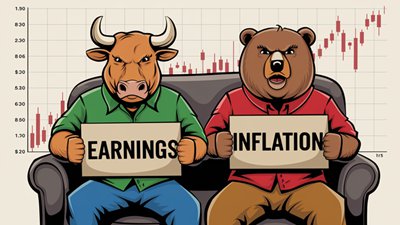MarketLens
What To Expect in the Markets This Week (July 22, 2024)
As we enter the week of July 22, 2024, the stock market is poised for a period of cautious volatility, influenced by recent political developments, economic indicators, and upcoming earnings reports. The withdrawal of President Joe Biden from the presidential race has introduced a layer of uncertainty, while expectations of Federal Reserve interest rate cuts and mixed economic signals will shape investor sentiment and market dynamics.
Current Market Overview
The stock market has recently experienced significant turbulence, with the S&P 500 suffering its worst weekly losses since April, declining nearly 2%, and the Nasdaq Composite dropping 3.7%. Futures for major indices, including the S&P 500 and Nasdaq-100, have shown slight increases, suggesting a potential rebound as traders digest recent events. However, the overall sentiment remains cautious, particularly in light of Biden’s exit from the presidential race, which analysts believe could lead to increased market volatility.
Political Landscape and Market Sentiment
Biden’s withdrawal from the presidential race, coupled with his endorsement of Vice President Kamala Harris as the Democratic nominee, has created a complex political environment. While some analysts suggest that the market’s reaction may be muted due to the anticipated nature of this announcement, the uncertainty surrounding the Democratic Party’s future direction could lead to fluctuations in investor confidence.
The potential for a “Trump trade unwind” is also a consideration, as investors recalibrate their expectations based on the evolving political landscape. This could particularly impact smaller capitalization stocks that had previously benefited from a favorable market environment.
Economic Indicators and Federal Reserve Expectations
Recent economic data presents a mixed picture. The U.S. economy is projected to have grown at an annualized rate of 1.9% in Q2 2024, a modest improvement from earlier in the year, driven by resilient consumer spending and inventory levels. However, the Leading Economic Index (LEI) has shown a contraction of 0.2% in June, indicating potential headwinds for future growth.
The Federal Reserve’s monetary policy is a critical factor in the current market outlook. With a nearly 93% likelihood of interest rate cuts in September, investors are shifting their focus toward rate-sensitive sectors, such as small caps and industrials, which typically benefit from lower borrowing costs. This shift is evident as traders rotate out of big technology stocks, reflecting a broader trend of cautious optimism in the face of potential economic easing.
Earnings Reports and Market Reactions
The upcoming week will see a flurry of earnings reports from major companies, including Reliance Industries and HDFC Bank, which are expected to influence market sentiment significantly. The performance of these companies will be closely monitored, particularly in light of the recent downturn in tech stocks and the overall market’s recent volatility.
Investors are also keenly aware of the implications of the Federal Reserve’s Beige Book report, which highlights uneven economic expansion across sectors. This report, along with the anticipated earnings, will provide further insights into the health of the economy and the potential for future growth.
Sector Analysis and Trends
Technology Sector
The technology sector has faced considerable pressure, particularly following the Nasdaq’s significant pullback. Companies like Apple and Palantir Technologies are at pivotal points, with the former integrating AI into its product line, which could positively influence market sentiment. However, the scrutiny surrounding cryptocurrency valuations, particularly for firms like Coinbase, adds a layer of complexity to the sector’s outlook.
Automotive and Transportation
The automotive sector, particularly companies like Ford, is showing signs of growth, especially in electric vehicles (EVs). This trend aligns with broader consumer preferences and regulatory shifts toward sustainable transportation (Kavout). Investors may find opportunities in this sector as it adapts to changing market demands.
Commodities and Inflation
Gold futures have seen a slight uptick, reflecting a safe-haven demand amid market uncertainties. Additionally, rising silver prices due to structural deficits may present investment opportunities in commodities. However, inflation remains a concern, particularly with rising food prices impacting consumer sentiment and spending.
Implications for Stakeholders
Investors
Investors should prepare for a week of heightened volatility as they navigate the implications of political uncertainty and economic indicators. The focus on earnings reports will be crucial, as positive results could bolster market confidence, while disappointing outcomes may exacerbate existing fears.
Corporations
Corporations must remain agile in responding to market conditions and consumer behavior. Companies that can effectively leverage technological advancements and adapt to economic shifts will likely outperform their peers.
Policymakers
Policymakers must consider the implications of their decisions on market stability. The Federal Reserve’s approach to interest rates will be pivotal in shaping economic conditions and investor sentiment in the coming months.
Conclusion
As we look ahead to the week of July 22, 2024, the stock market is navigating a landscape marked by political uncertainty, mixed economic signals, and critical earnings reports. While the potential for volatility exists, there are also opportunities for growth in sectors poised to benefit from technological advancements and changing consumer preferences. Investors should remain vigilant, closely monitoring developments in both the political and economic arenas, as these factors will significantly influence market dynamics in the near term. The upcoming week will be a crucial period for assessing the resilience of the market and the broader economy as stakeholders adapt to an evolving landscape.
Related Articles
Category
You may also like
No related articles available
Breaking News
View All →No topics available at the moment




